How Long Do LiFePO4 Batteries Last?
According to IRENA power generation costs, solar together with onshore wind energy are now the cheapest sources of electric energy. So there is no better time than now to get into the solar game and enjoy guilt-free and radiant peace of mind.
The biggest problem that solar and wind power experience was the question of storing the produced energy for later use. However, that problem, little by little, is being overcome by newer and better battery technologies that undauntedly continue to improve.
One of the latest and most efficient battery technologies for solar is the lithium-ion (Li-ion) battery technology which presents new perspectives to an existing problem.
In this article, we talk about:
- What Is A Lithium Battery?
- What is a Lithium Iron Phosphate LiFePO4 battery?
- LiFePO4 vs Lithium-ion Batteries
- How long do lithium batteries last?
- Do lithium batteries last longer?
- Lithium Iron Phosphate Battery Disadvantages
- Lithium (LFP) Battery Benefits
- How To Take Care Of Lithium Batteries?
- Safest Lithium Battery - Renogy Deep Cycle Lithium Batteries
If you are only interested in a particular topic above, feel free to use the above links to skip to your destination. That being said, we highly recommend you take the time to read the whole article and save you are interested
What Is A Lithium Battery?
Many people like you wonder what is lithium. Meaning they want to know the difference between lithium batteries and other types of batteries like lead acid.
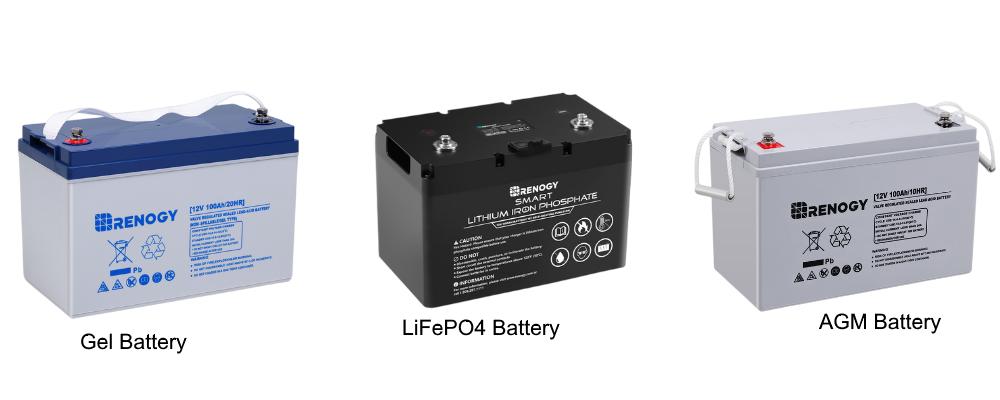
So what exactly is a lithium battery?
A lithium battery, also known as a lithium-ion (Li-ion) battery, is any type of battery that uses the mineral Lithium as one of the main components in its construction. Lithium batteries are known for their light weight and long lifespans and are used in many applications, from mobile phones, laptops, electric vehicles to solar generation.
Lithium-ion batteries typically follow the same design consisting of a cathode (positive electrode) made of some kind of Lithium metal, an anode (negative electrode) made of Graphite or Silicon, and a lithium salt as the electrolyte.
Some of the more notable types of Lithium-ion batteries are:
●Lithium Iron Phosphate LFP (LiFePO4)
●Lithium Cobalt Oxide LCO (LiCoO2)
●Lithium Manganese Oxide LMO (LiMn2O4)
●Lithium Nickel Cobalt Aluminium Oxide NCA (LiNiCoAlO2)
●Lithium Nickel Manganese Cobalt Oxide NMC (LiNixMnyCozO2)
●And more…
Since the 1960s Lithium batteries have gone through many changes with each successive generation being better in terms of cost, lifespan, energy density, and other aspects.
Nowadays, in solar energy circles, LiFePO4 (LFP) batteries are the best lithium-ion batteries on the market, boasting many areas where they are superior to other lithium and lead-acid batteries.
What is a Lithium Iron Phosphate LiFePO4 battery?
An LFP or LiFePO4 stands for lithium iron phosphate. If you are wondering where the ‘F’ comes from. It comes from Ferrum, the Latin word for Iron. LFP batteries have a Lithium Iron Phosphate cathode and Graphite anode, which gives them a lower energy density in exchange for increased safety and better performance in other aspects such as discharge rate.
So how does an LFP battery stack up to other lithium-ion batteries?
LiFePO4 vs Lithium-ion Batteries
We are going to compare Lithium iron phosphate (LiFePO4) batteries to other Lithium-ion batteries in six categories:
1.Cost
2.Energy Density
3.Energy Discharge Rate
4.Lifespan
5.Safety
6.Charging
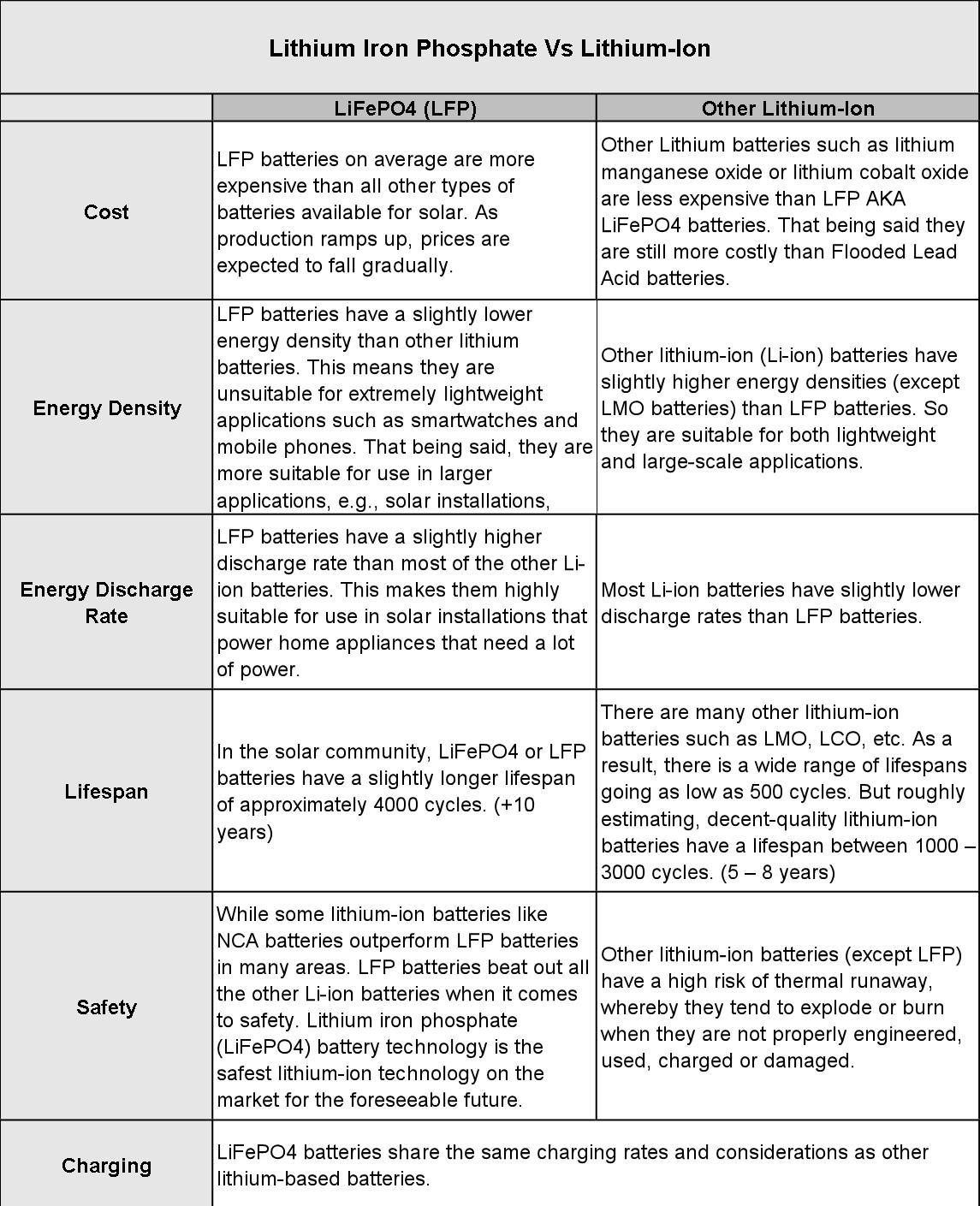
How long do lithium batteries last?
Roughly speaking, depending on the quality and type, your lithium battery can last anywhere from two to over ten years. More affordable lithium-ion batteries typically have between 500 and 3000 life cycles. While premium Lithium Iron Phosphate LFP batteries can last anywhere from 3500 to over 4000 cycles.
Other external factors also influence the performance and lifespan of your batteries. Therefore, proper storage and use will protect and preserve your batteries so they last longer.
When not being used, it’s recommended to store your batteries in a cool, dry place away from direct sunlight and heat. When recharging, you should follow the manufacturer’s instructions to prevent overcharging, misconfigurations and other actions that can negatively impact battery life. Doing this will ensure your battery will last for the longest possible time.
Do lithium batteries last longer?
Lithium batteries are well-known for having longer lifespans than other types of batteries. For example, LFP batteries have over 4000 charge-discharge cycles, that's over 10 years of daily use. Compared to other types of batteries, LFP batteries have 8x more lifespan than Flooded Lead-Acid batteries and over 4x more lifespan than Gel and AGM batteries.

Lithium Iron Phosphate Battery Disadvantages
Before buying a battery, it's important to understand its advantages and disadvantages. This will help you make informed decisions about which battery satisfies your needs.
Therefore, before moving forward with LFP batteries as your energys storage, take time to understand their caveats and benefits
1. High Cost: LiFePO4 batteries tend to be more expensive than other types of rechargeable batteries due to their special chemistry and manufacturing process. This can become an issue if multiple batteries are needed for a device or project as costs can quickly add up.
2. Low Energy Density: LiFePO4 batteries have a lower energy density than other types of batteries. This means that at the same size, rechargeable lithium iron phosphate batteries will contain less energy than other types. If a device requires higher levels of power or needs frequent recharges, this could be a disadvantage.
3. Regulation Issues: These batteries require extra components such as balancers to ensure proper functionality and prevent damage during charging and use which can increase complexity and cost in certain situations.
Lithium (LFP) Battery Benefits
1. Longer Lifespan – Lithium iron phosphate batteries are known to have longer lifespans than most other types of rechargeable batteries.
2. Increased Safety – Lithium iron phosphate batteries are designed with materials that allow for more efficient charge/discharge cycles without overheating or posing any safety hazards.
3. Lower Cost Over Time – While lithium iron phosphate batteries may cost more initially, they provide much greater value in the long run due to their longer lifespan and increased safety.
4. 80% - 100% Depth of Discharge – You can discharge LFP batteries almost completely without worrying about causing permanent, irreparable damage to your LFP battery.
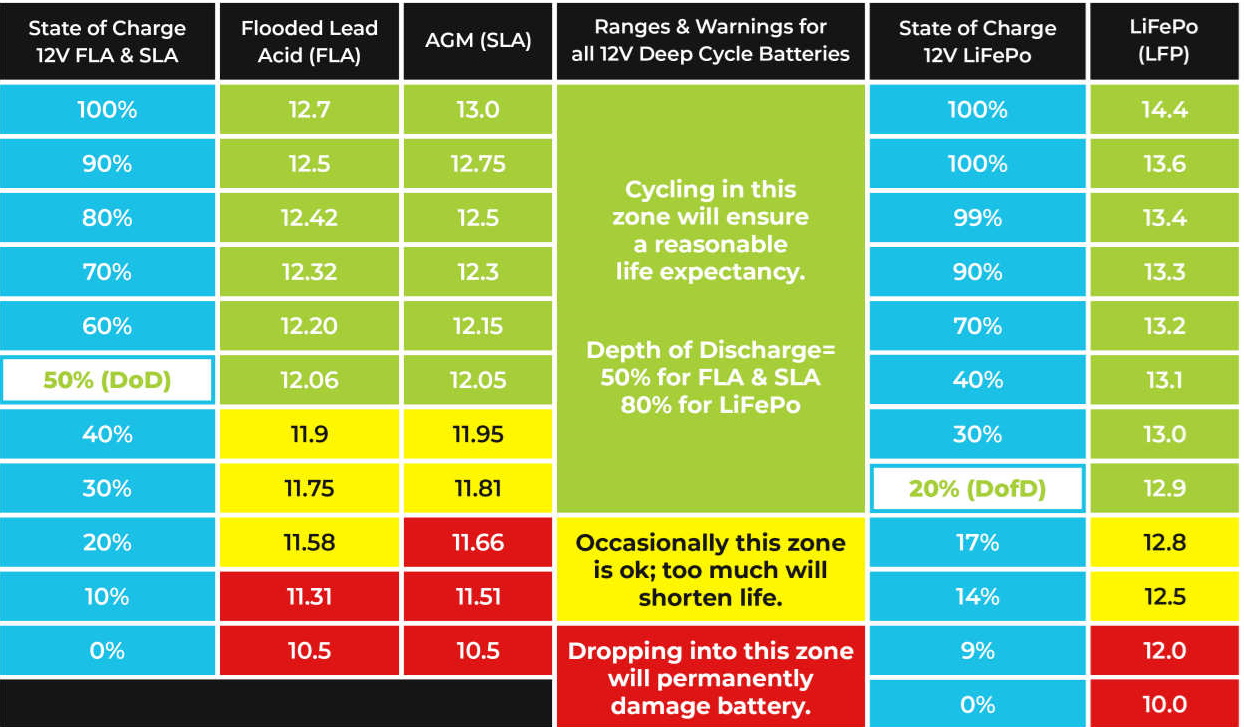
FLA, AGM & Lithium (LiFePO4) Battery SoC and Voltage Chart
5. Eco-Friendly: LFP batteries don’t contain dangerous substances or toxic metals that cause damage to the environment.
How To Take Care Of Lithium Batteries?
Lithium batteries are a powerful and versatile energy storage device but they can wear out over time. That’s why it's important to take proper care of them because otherwise, they won’t last long.
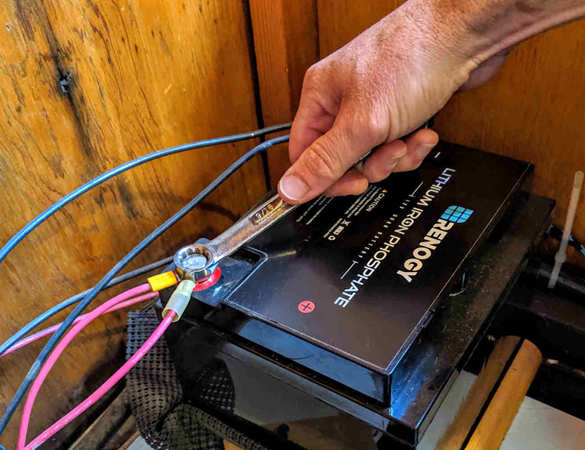
Here are some tips on how to take care of your lithium batteries:
1.Store Lithium Batteries Properly - It's important to store lithium batteries correctly so that their chemical properties remain the same. Keep the battery away from extreme temperatures, humidity and direct sunlight.
If you are going to store the battery for a long time, we recommend you store it at an SoC (state of charge) between 30% to 50%. Don't put away the battery at 100%.
2.Balance Partial Charge & Discharge Cycles - To enjoy the best Lithium-ion battery lifespan do not discharge your batteries completely. Lithium batteries perform best when they experience balanced cycles of charge and discharge. In short, don't leave your battery full and don't 100% discharge your batteries all the time.
3.Avoid Overcharging - Overcharging causes more strain on your lithium battery than normal usage does. Excessive voltage speeds up the degradation of your batteries.
4.Avoid Extreme Heat or Cold - Lithium batteries don’t perform well in extremely cold or hot environments. So if you plan to use a Lithium battery outdoors, make sure the environment is within the recommended optimal thermal range of the battery.
5.Handle with Care - Always keep careful track of where your battery is placed. Avoid dropping or bumping the battery since severe impacts can damage the battery.
By following these tips and tricks for taking proper care of your lithium-ion battery, you'll be able to max out your battery pack’s lifespan.
Safest Lithium Battery - Renogy Deep Cycle Lithium Batteries
Remember Samsung’s exploding phones with lithium batteries?
So does everyone else. Explosions and fires are a significant concern when using some lithium-ion batteries. That’s why airlines don’t allow larger lithium batteries on their planes as they present a hazard to their passengers.
The explosion and/or fire, AKA thermal runaway, in lithium-ion batteries (except LiFePO4) is due to the flammable electrolyte used in the batteries. So when the battery is improperly made, incorrectly used, or suffers damage, it often results in an explosion, fire, and toxic smoke.
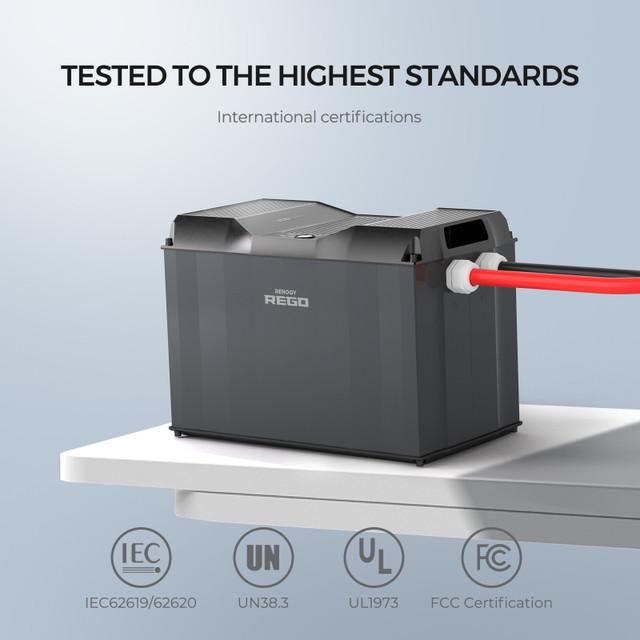
Fortunately, Renogy only sells the very best LiFePO4 batteries,, which are the safest lithium-ion battery on the market. LFP or LiFePO4 batteries have an electrolyte that won’t catch fire when the temperature reach 800 °C. The chemistry is highly stable. For more information, have a look at another article: Are Lithium Ion Batteries Dangerous And What Are The Safest Lithium Batteries?
We highly recommend you only buy the safest, high-quality LiFePO4 lithium batteries from reputable manufacturers with a proven track record like Renogy. This investment ensures your solar batteries won’t cause loss or damage to your property in case something goes wrong.
In addition to 12V lithium ion batteries, Renogy also sells reliable and safe AGM and GEL batteries that come at affordable pricing. We are sure to have the right solar solutions you need to install, upgrade, or replace your components.
Related articles:
Buy Lithium Solar Batteries In 2022: How To Choose A LiFePO4 Battery
Bluetooth Lithium Iron Phosphate Batteries For Solar: Everything You Need To Know
Are Lithium Batteries Worth The Investment
What To Know About Lithium Batteries
Renogy's REGO System Installation Tips, Product Review, & Score Card








